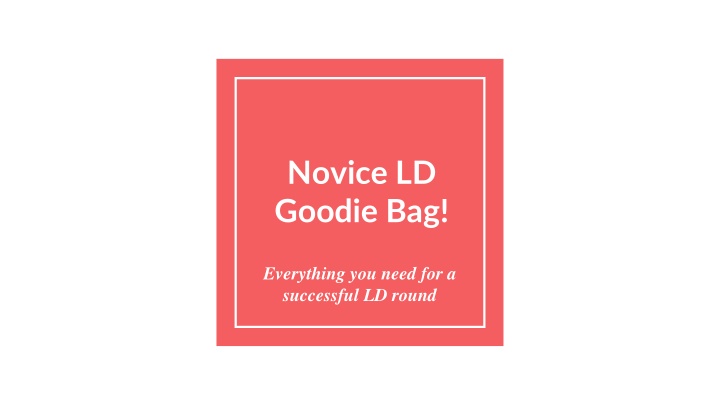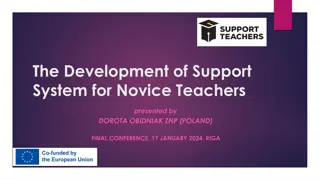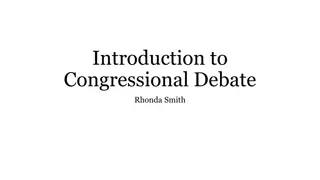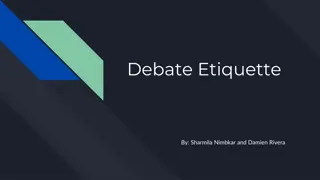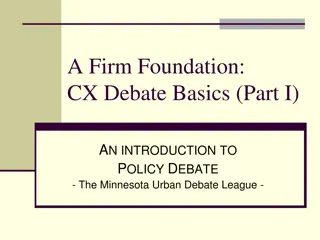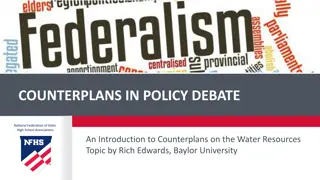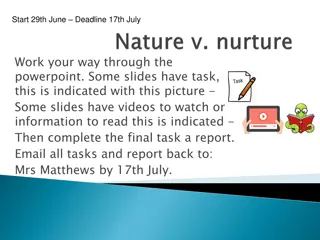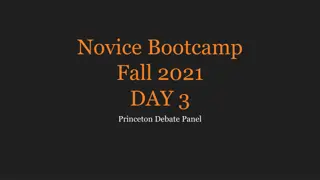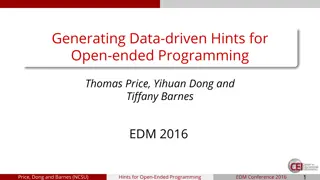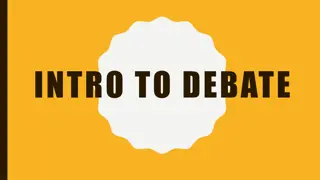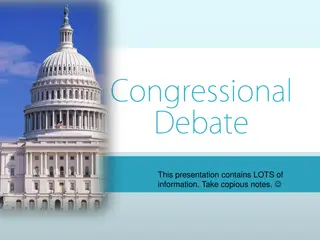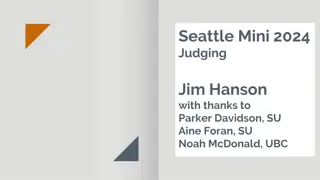Everything You Need to Know About Novice LD Debate
In Novice LD Debate, participants like Abraham Lincoln and Stephen Douglas engage in one-on-one debates following specific time allocations for affirmative and negative arguments. The resolution defines the topic to be debated, such as propositions of fact, value, or policy. Debate resolutions change every few months, providing debaters with ample opportunity to tackle various topics. Success in LD debate requires dedication and effort in researching, practicing, and participating in tournaments, among other activities.
Download Presentation

Please find below an Image/Link to download the presentation.
The content on the website is provided AS IS for your information and personal use only. It may not be sold, licensed, or shared on other websites without obtaining consent from the author.If you encounter any issues during the download, it is possible that the publisher has removed the file from their server.
You are allowed to download the files provided on this website for personal or commercial use, subject to the condition that they are used lawfully. All files are the property of their respective owners.
The content on the website is provided AS IS for your information and personal use only. It may not be sold, licensed, or shared on other websites without obtaining consent from the author.
E N D
Presentation Transcript
Novice LD Goodie Bag! Everything you need for a successful LD round
Lincoln-Douglas Debaters 1. Abraham Lincoln 2. Stephen Douglas 3. One-on-One 4. Affirmative - 6 minute constructive, 4 minute rebuttal, 3 minute rebuttal 5. Negative - 7 minute constructive, 6 minute rebuttal 6. Judge - will watch the round, evaluate the arguments, assess the delivery styles of the debaters, suggest places for each debater to improve and render a decision. There will always be a winner and loser in the round. That is not a criticism of who you are as a person, that is a the reality of competition. When you lose, don t lose the lesson. When you lose, don t lose the lesson.
The Resolution Defined - the proposition which will be debated. Proposition of Fact - proposes whether something is or is not, true or false. Frequently verifiable and often takes a more objective approach. Draws on logical inferences. Example: Converting to solar energy can save homeowners money. Proposition of Value - judges whether something is good/bad, right/wrong, just/unjust, ethical/unethical, desirable/undesirable. Example: It is wrong to avoid jury duty. Proposition of Policy - advocates a specific course of action. Example: The United States federal government should legalize medicinal marijuana.
Debate Resolutions for Texas NSDA/TFA - changes every 2 months. UIL - Changes twice each year, Fall topic and Spring topic. 2017 September/October: In the United States, national service ought to be compulsory. 2017 Fall: The United States federal government has a moral obligation to provide universal health care for its citizens. Used at TFA invitationals, TFA State, TOC s, NSDA qualifiers and the NSDA National tournament. Used at UIL practice meets, some TFA invitationals, and UIL Districts, Region, and State.
It will take more than some of your time; it will take more It will take more than some of your time; it will take more than a little of your effort. It will take everything you ve got. than a little of your effort. It will take everything you ve got. All of the time! Debate Class, home, after school rehearsals Tournaments - Debate competitions - Researching - Practice Rounds - Writing - http://www.uiltexas.org/academ ics/invitational-meets - Editing - Sparring - http://www.txfa.org/calendar.as p - www.joyoftournaments.com
Year at a glance Spring Fall - Practice Meets - Practice Meets - National Qualifier - TOC Bid Tournaments - TOC Bid Tournaments - TFA State - UIL District, Region, and State - Tournament of Champions Summer - NSDA Nationals
Reasons to Debate Professional 1. Confidence Personal 2. SAT/ACT scores 1. Confidence 3. Professional wardrobe 2. Passion 4. College connections 3. Knowledge 5. Scholarships/Grants 4. Wisdom 6. Writing Skills 5. Friendships 7. Logic skills 6. Your Tribe 8. Research Skills 7. Travel 9. College readiness
Research Sources Philosophy - Read original texts - John Locke - John Stuart Mill - John Rawls - Robert Nozick - Ayn Rand - Thomas Hobbes - Jean-Jacques Rousseau - Stanford Encyclopedia of Philosophy - Oxford Dictionary of Free Will Factual/Statistical - Research Institutes - Major Universities - Brookings Institute - Heritage Foundation - Cato Foundation - Topic Specific Research Institutes - Some news sources - Government agencies
Case Writing - Switch Side Debate Affirmative - 13 minutes - Affirms/defends the proposition - Gets the first and the last speech - Defines the terms of the resolution, sets the parameters of the debate - An advocate for change - The affirmative case should be 6 minutes long. - The case is referred to as a constructive speech, where arguments are introduced. Negative - 13 minutes - Negates/opposes the resolution - Gets less speeches, but longer speech times - Challenges the affirmative - An advocate for the status quo - The negative case should be 4 minutes long. - The case is referred to as a constructive speech, where arguments are introduced. Academic debate is not about being right or being wrong. It is about learning as much about the issues related Academic debate is not about being right or being wrong. It is about learning as much about the issues related to the resolution as you can over the course of the term of the resolution. You will be challenged to both defend to the resolution as you can over the course of the term of the resolution. You will be challenged to both defend and oppose the resolution. and oppose the resolution.
Basic Case Structure - both aff & neg Introductory Quotation Statement of the Resolution & position Value - - - - Criterion - - - - State it Define it Explain it Tie it to the Resolution State it Define it Explain it Tie it to the Value & the Resolution
Example Dr. Martin Luther King, Jr., stated, Injustice anywhere is a threat to justice everywhere. Because I agree with Dr. King, I must affirm today s resolution: Resolved: In the United States, national service ought to be compulsory. My value in today s round is Justice. Justice, defined by John Rawls, has two principles. 1.Principle of Equal Liberty - each person has an equal right to the most extensive liberties compatible with similar liberties for all 2.Difference Principle - social and economic inequalities should be arranged so that they are both a.) to the greatest benefit of the least advantaged person, and b.) Attached to offices and positions open to all under conditions of equality of opportunity.
Example Contd Rawl s principle of justice best answers the question of why national service ought to be compulsory through the application of the principles of justice via the social contract. When we understand the roles of the government and the citizen in a well-functioning society, we see that national service is part of the way citizens give do their part. The weighing mechanism in today s round will center around equality. Whoever provides a more egalitarian system will better achieve justice. National service tends to favor the privileged in society. Compulsory service would equalize the process, as it would be required for all.
Basic Case Structure Continued Contentions -arguments which prove your case 1.Claim - statement you claim to be true. EX: compulsory national service is beneficial to low income families. 2.Data - the factual/statistical information that supports your claim. (will be in your research and include a source citation) 3.Warrant - ties the research/data to the claim. Explain why your research/data/statistics/facts support your claim. 4.Impact - What is the result of your claim being true? How does it affirm/oppose the resolution? What does that mean for people in the United States? This will tie to the value/criteria and resolution.
Contentions contd How many contentions? - Affirmative - 3-4 - Negative - 1-2 They should stand independently - Each contention is an independent proof of the resolution. - Each must have all four parts - CDWI
The LD Round Speeches/Times - The LD Phone number 6 - 1AC - First Affirmative Constructive 3 - CX - Cross Examination 7 - 1NC - First Negative Constructive 3 - CX - Cross Examination 4 - 1AR - First Affirmative Rebuttal 6 - NR - Negative Rebuttal 3 - 2AR - Second Affirmative Rebuttal
1AC - 1st Affirmative Constructive I. Introduction: Build your case affirming the resolution A. Quotation B. C. Statement of Resolution Affirmation II. Value/Criteria The 1AC is a 6-minute prepared speech outlining why the resolution is true and should be affirmed. A. B. Value Criteria C. Tie Back to Resolution III. Contentions A. Contention 1 a. Subpoint A b. Subpoint B B. Contention 2 a. Subpoint A b. Subpoint B C. Contention 3 a. Subpoint A b. Subpoint B
CX - Cross Examination (3 minutes) After the Affirmative reads their case, the Negative has 3 minutes to ask questions. Effective Cross examination: 1. Clarifies anything you don t understand Affirmative Prep for CX - practice with your coach and teammates answering questions about your case, the resolution, etc. Anticipate questions you will be asked and prepare answers. 2. Gets a copy of the evidence read by your opponent. 3. Sets up arguments you will run 4. Points out any inconsistencies in the opponent s case/speech. Negative Prep for CX - Brainstorm questions to ask ahead of time, general questions from a negative perspective, questions that assist in setting up arguments you will run as the negative, etc.
1NC - 1st Negative Constructive 1NC Outline I. Introduction A. Quotation B. Statement of Resolution C. Statement of Position II. Value/Criteria A. Value B. Criteria C. Tie back to Resolution III. Contention A. Contention 1 1. Supbpoint A 2. Subpoint B IV. Refutation - A. Value/Criteria B. Contentions The 1NC does 2 important things in 7 minutes: 1. Builds the case of the negative for why the judge should oppose the resolution. (4 minutes) 2. Refutes the affirmative case. (3 minutes) You cannot win the round if you do not clash. This is called the Negative Burden of Clash. You MUST refute the affirmative position directly. Refutation should go in the order of the case outline.
CX - Cross Examination After the Negative reads their case & refutes the Affirmative, the Affirmative has 3 minutes to ask questions. Effective Cross examination: 1. Clarifies anything you don t understand 2. Gets a copy of the evidence read by your opponent. Affirmative Prep for CX - Brainstorm questions to ask ahead of time, general questions from a negative perspective, questions that assist in setting up arguments you will run as the negative, etc. 3. Sets up arguments you will run 4. Points out any inconsistencies in the opponent s case/speech. Negative Prep for CX - practice with your coach and teammates answering questions about your case, the resolution, etc. Anticipate questions you will be asked and prepare answers.
1AR - 1st Affirmative Rebuttal The 1AR must do a lot in 4 minutes! An Effective 1AR will: 1. Rebuild the Affirmative case following attacks by the 1NC. 1. Address the Value/Criteria and Contentions of the Negative case 2. Refute the 1NC Case. 2. Rebuild the Value/Criteria & Contentions of the Affirmative Case 3. Try to divide your time so that you have 2 minutes to Rebuild and 2 minutes to Refute 3. Employ effective grouping strategies 4. Employ both offensive and defensive argumentation 4. Refute in the order of the case outline
NR - Negative Rebuttal The NR is a 6-minute speech which does a couple of things: An effective NR will - Solidify the Negative Case, including: 1. Rebuild the Negative Position - Value/Criteria 2. Answer Affirmative refutation - Contentions 3. Crystalize/Summarize/Apply Voters - Answer the Affirmative responses to Negative attacks on the 1AC from the 1AR - Apply voting criteria for the judge
Crystallize/Voters Organize the arguments that have surfaced in the round into Voting Issues: Group all Value/Criteria arguments (from both sides) into 1 or 2 voters. Group contention arguments where they overlap. Summarize the debate for the judge.
2AR - 2nd Affirmative Rebuttal The 2AR is a 3 minute speech - you have time to give Voters and that s it. An Effective 2AR will: Group like a BOSS! Have very strong delivery - speak pretty! Summarize the debate
Flowing? Huh? Defined - specialized method of note-taking for debate rounds Purpose - To keep up with the progression of arguments in the round Who flows? - Both debaters and hopefully the judge(s) How do you flow? - use of abbreviations and symbols in columns across the page.
Sample Flow V. Justice Attack Justice, Promote Peace Defend Justice, Attack Peace Defend Peace, take Justice OUT! Summarize why your contentions are rock solid and the attempts of the negative to dismantle them are feeble and ineffective. Attack Rawls and his principles; insert the UDHR Defend Rawls, attack and/or subsume the UDHR Kill Rawls principles, elevate UDHR C. Rawls 2 Principles of Justice (don t forget, this is only one flow, you have another one also) Meet the obs. Or attack it Solidify we meet or kill the obs. Obs. (optional) Attack we meet or defend obs.
Sample Flow contd C1: U-HC is Just It s not just; PC is just It is just, PC is unjust Group C1 and C3 responses and beat them Summarize why Justice Wins, Why Rawl s is THE MAN, how his prinicples win the day and why the negative doesn t meet your observation and loses on a procedural. It s impractical It is practical, PC is impractical Win impractical, but even if you don t you ve won C1 & C3 C2: U-HC is practical PC is more practical C3 U-HC is moral U-HC is not moral, PC is moral It is moral, PC is immoral
